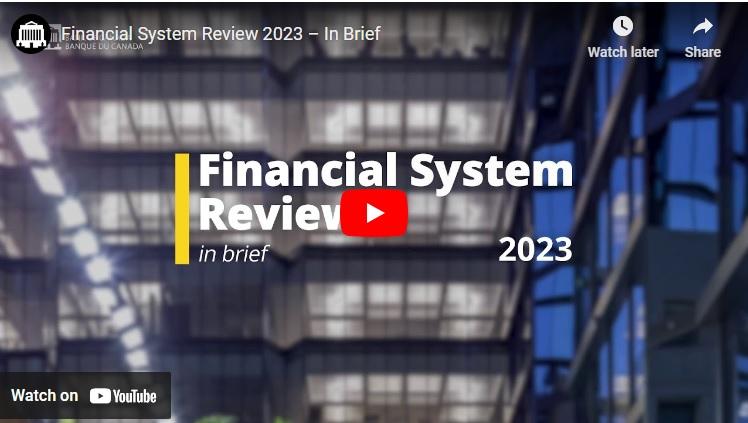
Financial system
The Bank of Canada plays an essential role in promoting and preserving the stability and efficiency of the Canadian financial system. This work helps to sustain economic growth and raise standards of living for Canadians.
In 2023, central banks continued to increase policy interest rates in response to high and persistent inflation. These elevated interest rates, while necessary to reduce inflation, tested the resilience of the global financial system.
In March, for example, banking sectors in the United States and Switzerland faced acute stresses. Authorities in those countries reacted swiftly to limit spillover effects. But these events underscored the need for financial system participants to adapt after more than a decade of low interest rates. These events also served as a reminder that risks can emerge and spread quickly, requiring increased vigilance from regulators and central banks.
Senior Deputy Governor Rogers explains in her speech why interest rates may stay higher than Canadians are used to and how, by adjusting early, we can minimize future financial risks.https://t.co/JcVDQPtCFn#cdnecon #FinancialStability @AdvocisVan pic.twitter.com/Mqnwi4WfOV
— Bank of Canada (@bankofcanada) November 9, 2023

https://twitter.com/bankofcanada/status/1722664154631147861
Adjusting to higher interest rates and tightened financial conditions
Global financial conditions have tightened considerably because of monetary policy actions to reduce inflation. The strong response by central banks—including the Bank of Canada—helped to bring inflation down from its June 2022 peak. But it also exposed weaknesses in the global financial system—notably, those inherent in business models relying heavily on both low interest rates and low volatility.
The stresses that appeared in the international banking sector in March 2023 brought these weaknesses to light. In Canada, however, the financial system proved resilient, partly because Canadian banks had only small direct exposures to the troubled American and Swiss institutions. Additionally, Canadian banks are held to the highest global regulatory standards and are subject to rigorous supervision.
Canadian banks—like those around the world—are generally more resilient today than they were before the 2008–09 global financial crisis. Financial institutions have made significant improvements in their financial buffers and risk management practices. Regulators, too, have taken important steps to ensure the Canadian financial system remains robust. However, if global financial stress re-emerges and becomes persistent, the stability of the Canadian financial system could face challenges.
Supporting the Bank’s financial system function
The Bank conducts rigorous research and analysis to inform its efforts to foster a stable and efficient financial system. It also collaborates with federal, provincial and international authorities as well as with industry.
Assessing vulnerabilities and risks
The 2023 Financial System Review (FSR) presented the Bank’s assessment of key vulnerabilities and risks to the financial system. Its theme in 2023 was the adjustment to large increases in interest rates. Throughout the year, the Bank continued to leverage microdata to track how this adjustment was playing out for households and the financial sector. The Bank’s key indicators of financial vulnerabilities suggested that early signs of financial stress had emerged.

https://www.youtube.com/watch?v=OPRcwXLCB3g
From a historical perspective, acute financial stress among Canadian households remained low in 2023. However, a severe recession could affect the ability of households to pay their mortgages, potentially leading to credit losses for lenders.
Additionally, the Bank analyzed the balance sheets of banks and non-bank financial institutions. Staff found that, although these institutions managed well in 2023, risks remain—notably to the cost and availability of funding.
As outlined in the FSR, the Bank continued to track other vulnerabilities and risks, such as those posed by climate change and digitalization. Staff published research and analysis on:
- the financing sources of Canadian organizations that report greenhouse gas emissions
- flood risks and their impact on lending for residential real estate
- climate transition risks and how they affect the financial system
- decentralized finance
Visit the Bank’s Financial System Hub for more information about its work in these areas.
Analyzing the link between monetary policy and financial stability
The financial system plays an important role in transmitting monetary policy. In 2023, the Bank continued to assess how this transmission is occurring in the current interest rate environment. For instance, microdata on mortgage payments helped the Bank understand how much of an effect higher interest rates have had—and are expected to have—on reducing borrowers’ disposable income.1
Considering the implications of financial market activity
As financial markets evolve, the Bank systematically conducts analysis to understand how these developments can affect the Canadian financial system, including its stability. In 2023, Bank staff conducted a variety of work in this area.
For example, staff analyzed the March 2020 trading behaviour in the Government of Canada bond market, at the peak of market turbulence. They found that hedge funds can contribute to one-sided markets and amplify declines in market liquidity.
Another study of the behaviour of market participants found that Canadian life insurers did not face significant draws on liquidity during recent stress periods (such as the COVID‑19 pandemic) and were able to maintain their usual investment activities. In contrast, other types of asset managers saw their liquidity needs increase significantly and therefore likely contributed to market stress during these periods.
Bank staff also found that options markets can provide a gauge of investor risk sentiment during times of stress. A review of the price movements of options on exchange-traded funds suggested that investors did not anticipate an adverse scenario for major Canadian banks or the economy during the global banking turmoil in March 2023.
These studies helped shed light on how different market participants respond during stress episodes.
Promoting financial system resilience
The Bank worked closely with federal and provincial authorities in 2023 to monitor and assess the resilience of Canada’s financial system.
This collaboration included the Bank’s continued leadership of the Heads of Regulatory Agencies Committee and the Systemic Risk Surveillance Committee. Through these federal–provincial forums, the Bank helped improve information sharing on important financial system topics.
The Bank continued to work with industry through the Canadian Fixed-Income Forum (CFIF). Efforts focused on promoting an efficient and robust market for fixed‑income securities for Canada. The Bank also agreed to co-chair the Collateral Infrastructure and Market Practices Advisory Group (CIMPA). This new industry working group will foster operational efficiency in the Canadian markets for securities financing and collateral. The group will also identify areas for potential improvement and implement and promote recommended solutions.
Ensuring a robust interest rate benchmark regime for Canada
The Canadian Alternative Reference Rate Working Group (CARR), which is co-chaired by the Bank, continued its work in 2023 to advance benchmark reform in Canada. It completed the first stage of its two-stage transition plan to move the market away from the Canadian Dollar Offered Rate (CDOR). As of the end of June, market participants had adopted pricing based on the Canadian Overnight Repo Rate Average (CORRA) for almost all new derivative and securities transactions.
To support the second stage of the plan—and since CDOR will no longer be published after June 2024—the Bank worked with CARR members to encourage the loan market to quickly adopt CORRA. The 2023 launch of CARR’s forward-looking one- and three-month term CORRA benchmarks will help this stage of the transition.
In October, CFIF announced its proposed path for winding down the issuing of bankers’ acceptances (BA). This path will ensure the Canadian money market continues to function well. In recent years, BAs have been the second-largest product in Canadian money markets after treasury bills; they will no longer be issued after CDOR disappears.
Overseeing payments and financial market infrastructures
The Bank is responsible for overseeing Canadian financial market infrastructures that have the potential to pose systemic or payment system risks. In October 2023, the Bank designated four payment systems as prominent under the Payment Clearing and Settlement Act:
- Visa Inc.’s VisaNet
- Mastercard International Inc.’s Global Clearing Management System
- Mastercard International Inc.’s Single Message System
- Interac Corp.’s Inter-Member Network
The designation of these systems brings them under formal Bank oversight and requires them to follow the Bank’s risk management standards. This will help ensure the systems remain safe, viable and effective methods of payment for Canadians.
Looking forward
In 2024, the Bank will continue to:
- closely monitor how households, businesses and the financial system adjust to a higher interest rate environment
- use microdata to enrich its understanding of financial vulnerabilities and provide timely updates to Canadians on how these vulnerabilities are evolving
- work closely with domestic and international partners to share information and promote the resilience of Canada’s financial system
- complete benchmark reform to help ensure Canadian markets function well by finalizing and supporting the smooth transition away from CDOR
More information
Global Financial Stability Reports from the International Monetary Fund
- 1. See M. teNyenhuis and A. Su, “The impact of higher interest rates on mortgage payments,” Bank of Canada Staff Analytical Note No. 2023-19 (December 2023).[←]